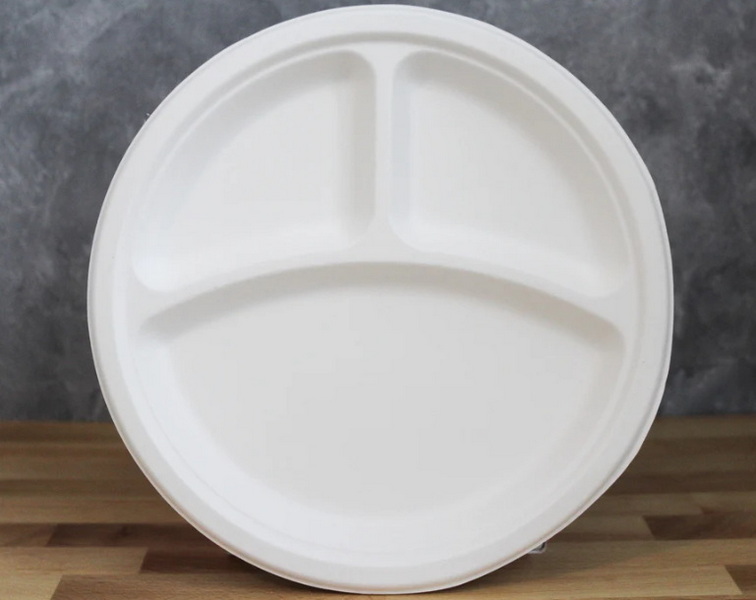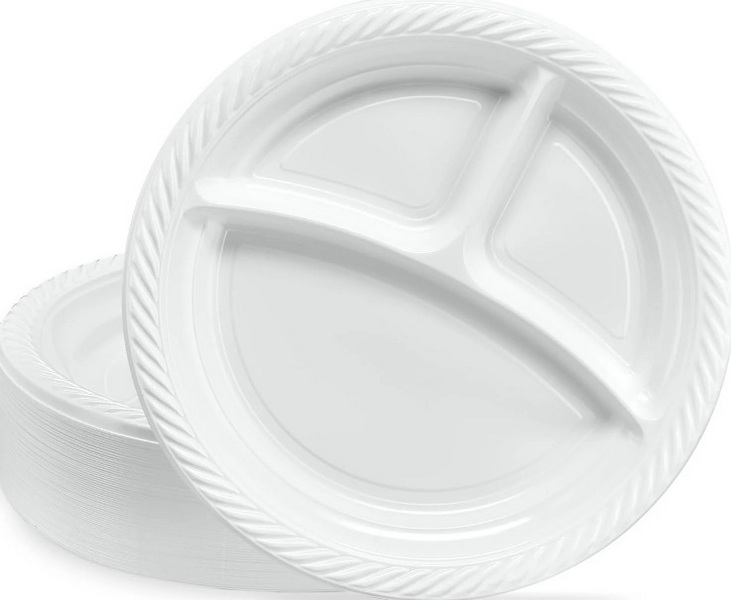
Content Menu
● Introduction to Disposable Plates
>> Paper Plates
>> Plastic Plates
>> Sugarcane Bagasse Plates
>> Bamboo Plates
● Recycling Process for Disposable Plates
>> Paper Plates Recycling
>> Plastic Plates Recycling
>> Composting Sugarcane and Bamboo Plates
● Challenges in Recycling Disposable Plates
● Innovations in Biodegradable Plates
● Alternatives to Disposable Plates
● Benefits of Recycling Disposable Plates
● Conclusion
● Frequently Asked Questions
>> 1. Can All Three Portion Disposable Plates Be Recycled?
>> 2. How Do I Recycle Paper Plates?
>> 3. Are Sugarcane Bagasse Plates Compostable?
>> 4. Can Plastic Plates Be Recycled?
>> 5. What Are the Most Eco-Friendly Disposable Plates?
● Citations:
In recent years, the use of disposable plates has become increasingly popular due to their convenience and affordability. Among these, three portion disposable plates are particularly favored for their ability to keep different foods separate, making them ideal for events, parties, and daily use. However, the environmental impact of these plates raises important questions about their recyclability. In this article, we will delve into the world of disposable plates, focusing on three portion disposable plates, and explore whether they can be recycled.

Introduction to Disposable Plates
Disposable plates are made from various materials, including paper, plastic, bamboo, and sugarcane bagasse. Each material has its own set of environmental implications and recycling possibilities.
Paper Plates
Paper plates are a common alternative to plastic plates, often perceived as more eco-friendly. However, their recyclability depends on their composition and condition. Clean, uncoated paper plates can be recycled, but those with plastic or wax coatings, or contaminated with food residue, cannot be recycled through standard processes.
Paper plates contribute to deforestation and resource depletion due to the trees cut down for their production. Additionally, their manufacturing process consumes significant energy and water, leading to a higher carbon footprint[2][7]. The use of chemicals like bleach in production can also harm the environment by polluting water[7].
Plastic Plates
Plastic plates, while recyclable in theory, often face challenges in practice. Not all types of plastic are accepted by recycling facilities, and contamination with food residue complicates the recycling process.
Plastic plates marked with recycling symbols and codes can be recycled. For instance, polypropylene (PP) and polystyrene (PS) are commonly used and recyclable[6]. The recycling process involves sorting, cleaning, shredding, and melting the plastic into pellets, which are then used to make new products[6].
Sugarcane Bagasse Plates
Sugarcane bagasse plates are made from renewable resources and are certified compostable. They offer a sustainable alternative to traditional disposable plates.
These plates are biodegradable and can be decomposed in commercial composting facilities, reducing waste and supporting a circular economy[3].
Bamboo Plates
Bamboo plates are another eco-friendly option, made from biodegradable bamboo fibers. They are compostable and do not contain plastic or wax coatings.
Bamboo is a highly renewable resource, and using it for plates reduces the demand on forests and minimizes environmental impact.
Recycling Process for Disposable Plates
The recyclability of three portion disposable plates depends on their material composition. Here's a general overview of the recycling process for different types of plates:
Paper Plates Recycling
1. Collection: Paper plates are collected along with other paper products.
2. Sorting: Plates are sorted based on their condition and composition.
3. Cleaning: Plates are cleaned to remove contaminants.
4. Pulping: Clean plates are turned into pulp.
5. De-inking: Ink is removed from the pulp.
6. Bleaching: Pulp is bleached to ensure whiteness.
7. Rolling: Pulp is rolled and dried into new paper products.
Plastic Plates Recycling
1. Collection: Plastic plates are collected and sorted by type.
2. Cleaning: Plates are cleaned to remove food residue.
3. Shredding: Plates are shredded into small pieces.
4. Melting: Shredded plastic is melted into pellets.
5. Manufacturing: Pellets are used to make new plastic products.
Composting Sugarcane and Bamboo Plates
1. Collection: Plates are collected and placed in compost piles.
2. Decomposition: Plates break down naturally into compost.
3. Use: Compost is used as nutrient-rich soil.

Challenges in Recycling Disposable Plates
Despite the potential for recycling, several challenges hinder the process:
- Contamination: Food residue and coatings can render plates non-recyclable.
- Facility Availability: Not all recycling facilities can process coated or contaminated plates.
- Public Awareness: Lack of understanding about what can and cannot be recycled.
Innovations in Biodegradable Plates
The market for biodegradable plates is expanding rapidly, driven by growing consumer awareness and demand for sustainable products. Innovations such as algae-based bioplastics and mushroom-based materials are being developed to create even more eco-friendly tableware[3].
These materials not only decompose quickly but also have minimal environmental impact during production. Additionally, advancements in material science are improving the durability and heat resistance of biodegradable plates, making them more suitable for a wider range of uses[3].
Alternatives to Disposable Plates
For those seeking to reduce waste, reusable plates made from materials like ceramic, glass, or stainless steel are the most environmentally friendly option.
Reusable plates can significantly reduce waste by diverting single-use items from landfills. For example, Monash University implemented a reusable plate program, successfully diverting thousands of pieces of single-use packaging from landfills[4].
Benefits of Recycling Disposable Plates
Recycling disposable plates offers numerous benefits, including reducing waste, conserving resources, protecting wildlife, and supporting a circular economy[1]. By recycling, we keep usable materials out of landfills and reduce the need for raw materials, which in turn helps protect wildlife by preventing litter from being mistaken for food[1].
Conclusion
Recycling three portion disposable plates is feasible but depends heavily on their material composition and condition. While some plates can be recycled or composted, others may not be suitable due to contamination or coatings. By choosing eco-friendly materials and properly disposing of waste, we can reduce environmental impact.

Frequently Asked Questions
1. Can All Three Portion Disposable Plates Be Recycled?
No, not all three portion disposable plates can be recycled. Their recyclability depends on the material and whether they are contaminated with food residue or have coatings like plastic or wax.
2. How Do I Recycle Paper Plates?
To recycle paper plates, ensure they are clean and dry. Check with your local recycling facility for specific guidelines, as not all facilities accept paper plates.
3. Are Sugarcane Bagasse Plates Compostable?
Yes, sugarcane bagasse plates are certified compostable and can be decomposed in commercial composting facilities.
4. Can Plastic Plates Be Recycled?
Yes, some plastic plates can be recycled, but it depends on the type of plastic and local recycling guidelines. Ensure the plates are clean and sorted correctly.
5. What Are the Most Eco-Friendly Disposable Plates?
The most eco-friendly disposable plates are those made from compostable materials like sugarcane bagasse or bamboo. These plates are biodegradable and do not contain plastic or wax coatings.
Citations:
[1] https://smartyhadaparty.com/blogs/home/recycling-disposable-dinnerware-guide
[2] https://www.greenwashingindex.com/eco-friendly-or-silent-polluter/
[3] https://cosmosecofriends.com/the-future-of-biodegradable-plates-innovations-and-trends/
[4] https://www.sustainability.vic.gov.au/circular-economy-and-recycling/in-a-business-2/single-use-plastics-ban-centre/case-studies-reuse-pilot-projects/monash-university-case-study
[5] https://www.kimecopak.ca/blogs/news/are-disposable-paper-plates-recyclable
[6] https://smartyhadaparty.com/blogs/home/are-disposable-plastic-plates-really-recyclable
[7] https://babacups.com/everything-you-need-to-know-about-using-food-paper-wrap-6-2-2-2/
[8] https://www.17goalsmagazin.de/en/9-innovations-to-up-cycle-plastic-waste/
[9] https://cleanwater.org/publications/rethink-disposable-case-study-manila-eatery
[10] https://www.eastwenatcheewa.gov/338/Recycling-Solid-Waste
[11] https://www.thekayacollection.com/blogs/news/why-use-disposable-plates-convenience-benefits-tips-for-choosing-the-best-ones
[12] https://www.quitplastic.in/post/the-environmental-impact-of-traditional-disposable-tableware
[13] https://skinnonews.com/global/archives/4146
[14] https://cleanwaterfund.org/author/rethink-disposable-case-studies
[15] https://www.recyclebycity.com/chicago/notebook/pre-party-tips-for-a-waste-free-shindig
[16] https://www.anchenggy.com/blog/disposable-plates-vs-compostable-plates-making-eco-friendly-choices.html
[17] https://www.epd.gov.hk/epd/sites/default/files/epd/english/environmentinhk/waste/pub_consult/files/tableware-con-doc-en.pdf
[18] https://www.quitplastic.in/post/introducing-india-s-eco-innovation-9-inch-sugarcane-bagasse-plain-plates
[19] https://www.fspphk.org/images/en/best_practice_guide.pdf
[20] https://greenpaperproducts.com/blog/the-importance-of-eco-friendly-disposable-tableware-for-food-businesses

















